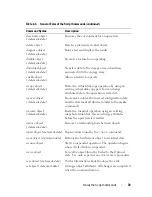
20
About the Command Line Interface
-g
Use to specify an ASCII file that contains email sender
contact information to include in all email alert
notifications. The CLI assumes the ASCII file is text only,
without delimiters or any expected format. A typical file
contains the following information:
• Name
• Title
• Company
• Phone
• Pager
NOTE:
You can use any file name that your operating system
supports. You must not use
userdata.txt
. Some operating
systems reserve
userdata.txt
for system information.
-h
Use with the
-a
and
-x
parameters to specify the host name
that is running the SNMP agent to which the storage array
is connected.
-I
Use to specify the type of information to be included in
the email alert notifications. The following are valid
information arguments:
•
eventOnly
— Only event information is included in the
email.
•
profile
— Event and array profile information is included
in the email.
•
supportBundle
— Event and support bundle
information is included in the email.
NOTE:
You can enter only one information argument each
time you execute the command. If you want all of the
information, you must run the command three times.
-i
Use with the
-d
parameter to display the IP address of the
known storage arrays.
-m
Use to specify the host name or IP address of the email
server from which to send email alert notifications.
Table 1-2.
Command Line Parameters
(continued)
Parameter
Definition
Summary of Contents for PowerVault MD3000i
Page 12: ...12 Contents ...
Page 42: ...42 About the Script Commands ...
Page 90: ...90 Using the Virtual Disk Copy Feature ...
Page 104: ...104 Maintaining a Storage Array ...
Page 222: ...222 Script Commands ...
Page 228: ...228 Sample Script Files ...
Page 236: ...236 Index ...
















































